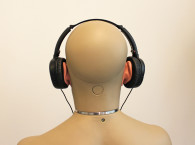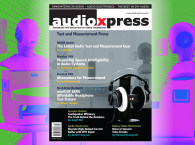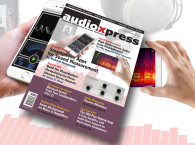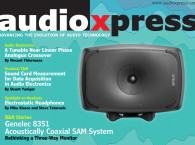
“I Can Hear It. Why Can’t I Measure It?” is the title of an excellent article written by Dan Foley and featured in this month’s issue. It could also be the slogan for our audioXpress March 2016 issue, which focuses on Test and Measurement. We tried to combine reviews, and practical and theoretical perspectives for this issue.
Since this is obviously about audio, we start with an exclusive review of a new device that is going to be important for the industry. In his Headsets column, Mike Klasco discusses the new G.R.A.S. 43BB Low-Noise Ear Simulator, which enables us to test headphones, earphones, and hearing aid devices with an extended bandwidth, up to 20 kHz. This is an industry first and we are certain that the new G.R.A.S. 43BB solution will be of great interest globally. Of course, we also discuss the new G.R.A.S. KB5000 right pinna with anthropometric concha and ear canal for the KEMAR Head-and-Torso Simulator (HATS), which is made of soft silicone and now closely mimics the properties of a real human ear. We also talk about the new generation KEMAR, a critical solution for these applications.
As referenced, in “I Can Hear It. Why Can’t I Measure It?,” Dan Foley discusses how audible distortion can be difficult to measure and explores the instrumentation noise floor’s impact on what can be measured. As he explains, instrumentation noise floor is an overlooked contributor for the reason we are not able to measure a particular audible “distortion,” especially with low sound pressure level (SPL) signals.
And continuing with our focus on test and measurement, Stuart Yaniger provides an in-depth look at the Virtins Multi-Instrument Software, for data acquisition and measurements. This is a great continuation for Yaniger’s article series “Sound Cards for Data Acquisition in Audio Measurements, which already included a quick overview of some of the available software packages. Among those mentioned, the Multi-Instrument package from Virtins Technology—a Singapore-based company—is one of the most powerful and versatile. This article is a very complete review of what Multi-Instrument entails and what distinguishes it from other software packages and dedicated solutions.
This month, our regular Sound Control column by Richard Honeycutt also focuses on test and measurement. After discussing how to measure reverberation time, his article explores various statistical methods that can be used to calculate reverberation time (RT) in acoustical applications, without modeling software. It is an article we are certain many readers will refer back to frequently.
We also decided to learn more about one of the leading manufacturers of test and measurement solutions for acoustics, audio and vibration applications. In Questions & Answers, Shannon Becker talks to Philipp Schwizer, CEO of NTi Audio headquartered in Schaan, Liechtenstein. NTi Audio specializes in fast end-of-line audio testing for manufacturing quality control purposes, provides solutions for testing public address systems in safety-critical environments, and also produces handheld audio analyzers and generators aimed at the professional audio industry. Read on to learn more about the company from one of its founders.
And for those readers who seek tube articles, we have something that we are certain will be of great interest and be the topic of many passionate debates. In “One Model to Rule Them All,” Christopher Paul explains his proposal for a unified model that could accurately predict the gains, the frequency responses, the impedances, and the power supply rejections (the “Four Horsemen”) of three separate circuits: the cathode follower, the cathodyne/concertina/ phase splitter, and the voltage gain stage (the “Big Three”). As Paul explains, “These three circuits differ only in component values and bias voltages, so we should expect some commonality here.” This is an article that’s been long in the works and we are certain will be an interesting read for many.
Richard Honeycutt’s regular Hollow-State Electronics column covers the testing of tubes. In previous issues he has discussed the various tube testers that have been used during the long history of hollow-state electronics. This month’s article focuses on the AT1000 Electron Tube Test System, manufactured by Amplitrex Audio Products, LLC. This a practical and complete device that couples the convenience of a simple emission tester with the precision of an AC parametric tester and enables testing of hundreds of popular vacuum tubes for emission, transconductance, and gas/leakage. It can also be used to test pentodes and tetrodes in triode mode.
And what about the DIY and hands-on experience? How about “Building an Audio Headroom Meter”? James B. Wood explains how to construct a simple, inexpensive meter that provides a visual presentation of headroom utilization. It is a complete DIY project, which can also be easily integrated and expanded.
And finally, Ron Tipton details some of his experiences with Room Correction. He discusses the use of solutions such as IK Multimedia’s ARC System 2, which consists of a calibrated measurement microphone and software package, as well as what’s possible with the miniDSP 2x4 hardware module, which also provides useful features for room correction, connecting to a computer via USB and serving as a dedicated processor after that.
Plenty to read, experiment and reflect on this special issue, which is now available to download at www.gotomyxpress.com
Of course you can also subscribe here www.audioxpress.com/page/audioXpress-Subscription-Services.html
And you can also buy a single printed issue at www.cc-webshop.com






